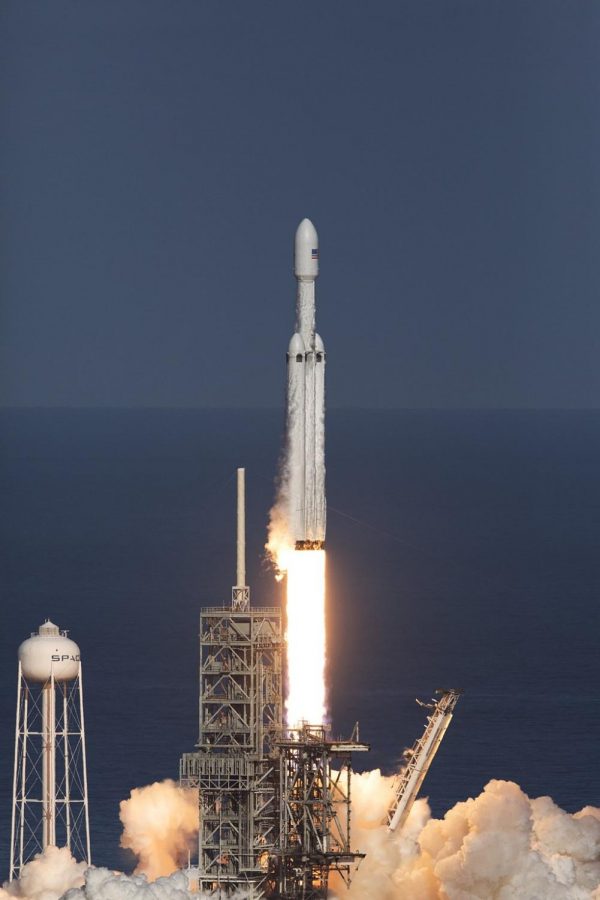SpaceX launches Falcon Heavy rocket
SpaceX Falcon Heavy rocket begins its demonstration flight with liftoff at 3:45 p.m. EST from from Launch Complex 39A at NASA’s Kennedy Space Center in Florida. By NASA/Kim Shiflett (Flickr) [Public domain], via Wikimedia Commons
Space flight may have been reborn with the recent launch of SpaceX’s groundbreaking rocket, the Falcon Heavy.
At 3:45 p.m. on Feb. 6, the Falcon Heavy rocket launched from the Kennedy Space Center in Cape Canaveral, Florida. The rocket is the largest since the Saturn V booster, which served the Apollo missions to the moon and the Space Shuttle missions.
SpaceX is a private rocket building firm headed by Elon Musk, who is also the co-founder and CEO of Tesla Motors.
The Falcon Heavy is the aerospace company’s newest product and can lift up to 64 metric tons, or 141,000 pounds, into Earth’s orbit according to the SpaceX website. This weight is greater than that of an entire passenger jetliner filled to capacity. According to Space.com, the new rocket stands 23 stories tall and can provide 5 million pounds of thrust at liftoff.
The rocket carried a red Tesla Roadster car during its launch. Inside the car was a mannequin outfitted with SpaceX’s new space suit. According to Tech Crunch, the car also includes a special data storage device called “The Arch,” which can hold massive amounts of data from Earth and is designed to last for a millennia. The car will now be jettisoned and sent on a trajectory orbit around the sun.
“From an IT perspective, you basically just put the sum of all human knowledge into space,” said adjunct instructor of computing technology and information systems Michael Raper. “For 14 billion years.”
According to Space.com, the Falcon Heavy rocket has been in development since 2011 and was nearly abandoned several times before it was ready. The project has resurrected America’s long history with space exploration.
The United States’ space program, NASA, has dominated space travel for four decades. It was responsible for sending astronauts Neal Armstrong and Buzz Aldrin to the moon in 1969 as part of the Apollo program. The program is also accredited for launching the successful Space Shuttle missions starting in 1981 and ending in 2011.
The program has been largely quiet since, but the Falcon Heavy flight could change that.
“This is a test flight,” Musk said to Space.com the day before the launch. “If the test flight works, I think we’d be ready to put satellites on the next mission.”
The mission that Musk predicted could now happen within three to six months, generating excitement among scientists.
“They cost one third as much and carries double the payload. It’s way more cost efficient,” said Raper. “As far as us being able to put up satellites cheaply and quickly and larger satellites, this is huge. If they can make this a repeatable option and they don’t have troubles with it it’s a game changer.”
Other Guilfordians have echoed this sentiment.
“My childhood was dominated by images of the shuttle,” said Don Smith, Professor of Physics. “There was still a visceral sense of ‘we’re pushing the envelope, we’re seeing what’s out there,’ and that I feel like has kind of stalled, and I hope that things like this can bring that up again.”
This excitement is propelled in part by the ingenuity of the Falcon Heavy rocket design. The unique rocket was lifted into orbit by three rocket boosters designed to return to Earth and land in upright positions.
On previous rockets, the boosters were jettisoned into the ocean after the rocket reached a certain height. Two of the Falcon Heavy boosters detached from the rocket and returned to Cape Canaveral simultaneously, a feat never accomplished before. The ingenuity of the returning boosters is in their ability to navigate back to Earth and their reusable factor for future missions. This will help drive the cost of space flight down, making missions beyond the globe easier and more accessible.
“Scientists try to explore and push the boundaries by finding new ways of solving complex problems,” said professor of computing technology and information systems Chafic Bou-Saba.
Many hope that pushing these boundaries will reignite national enthusiasm for upcoming astronomical advances.
“I hope that this can spark a resurgence of interest in the space program,” said Smith. “I hope that we don’t lose the national vision of wanting to do it as a country, rather than just letting private industry do it.”
The Falcon Heavy is already sparking interest in people around the country, creating a new frontier in space travel that might prove itself impossible not to explore.









